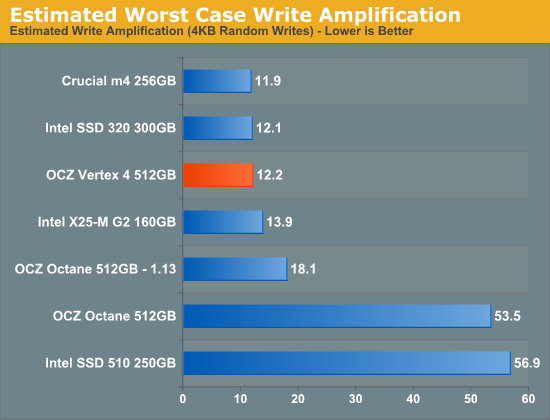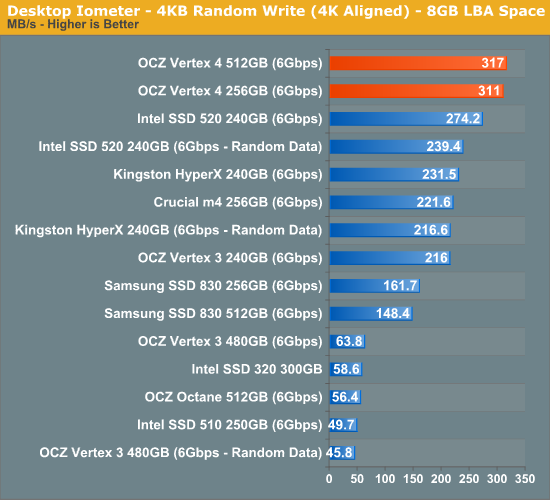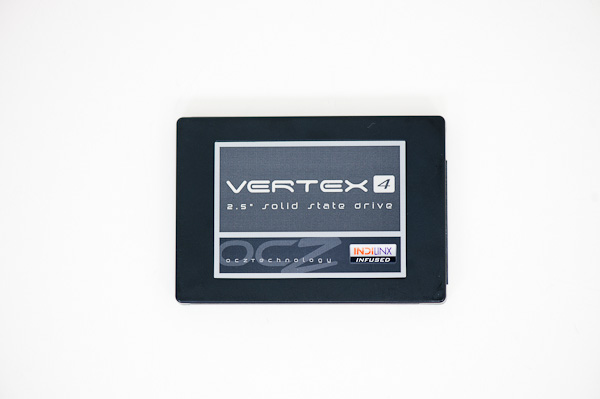OCZ Vertex 4 Review (256GB, 512GB)
by Anand Lal Shimpi on April 4, 2012 9:00 AM ESTThirteen months ago OCZ announced its intention to acquire Indilinx, the SSD controller maker that gave Intel its first taste of competition in the consumer market in 2009. Eight months later, OCZ launched its first post-acquisition SSD based on Indilinx silicon. Today, just five months after the launch of the Octane, OCZ is officially releasing the Vertex 4 – based on its Indilinx Everest 2 silicon. In less than a year, OCZ has brought to market more Indilinx powered controllers than Indilinx did in the previous three years. It's rare that you see the fruits of acquisition so quickly, but if there's anything OCZ's CEO Ryan Petersen is good at it's pushing for an aggressive schedule.
Rather than call this drive the Octane 2, OCZ went with Vertex 4, indicating its rightful place at the top of OCZ's SSD lineup. The implications run even deeper. It marks the first time in two years that a Vertex drive will ship without a SandForce controller inside. Make no mistake, while Octane was a shot across SandForce's bow, Vertex 4 means war. While OCZ continues to ship tons of SandForce controllers, the future for the company is Indilinx. The Vertex 4 is just the beginning. OCZ will continue to ship Vertex 3 in parallel, and should a future SandForce controller make competitive sense to use OCZ will definitely consider it, but the intention is to build the fastest silicon internally and use it as much as possible.
The dramatic departure in naming also embodies just how different Everest 2 is from the original Everest controller. OCZ claims there's minimal shared code between the Octane and Vertex 4 firmware, and the two drives perform very differently. Write amplification was always a concern with the Octane - it is no longer a major issue with the Vertex 4. OCZ and its Indilinx team have reduced write amplification to roughly the levels of Intel's controllers:

Indeed write performance is improved significantly as a result. A look at the spec sheet gives us the first indication of what's to come:
| OCZ SSD Comparison | ||||||
| OCZ Vertex 4 | OCZ Vertex 3 | OCZ Octane | OCZ Vertex 2 | |||
| Current NAND | 25nm IMFT MLC | 25nm IMFT MLC | 25nm IMFT MLC | 25nm IMFT MLC | ||
| Capacities | 128, 256, 512GB | 60, 90, 120, 240, 480GB | 128, 256, 512GB, 1TB | 60, 120, 240GB | ||
| Controller | Indilinx Everest 2 | SF-2281 | Indilinx Everest | SF-1221 | ||
| Max Seq Read | 535 MB/s | 550 MB/s | 480 MB/s | 285 MB/s | ||
| Max Seq Write | 475 MB/s | 500 MB/s | 330 MB/s | 275 MB/s | ||
| Max Random Read | 95K IOPS | 60K IOPS | 26K IOPS | - | ||
| Max Random Write | 85K IOPS | 85K IOPS | 35K IOPS | 50K IOPS | ||
| AES-256 Encryption | Yes | Yes | Yes | No | ||
Regardless of the nature of the data (compressible or incompressible), the Everest 2 powered Vertex 4 promises better random write performance than any other consumer SSD on the market today. And it delivers:

Random write speed is nothing short of incredible. OCZ is able to equal SandForce's write speed on highly compressible data without resorting to any sort of data compression. This is a purely algorithmic advantage. While the original Everest was a work in progress by the time OCZ acquired the company, Everest 2 is the first Indilinx project OCZ had complete control over. Apparently OCZ's CEO, Ryan Petersen had a lot of his own input built into this design.
| OCZ Vertex 4 Lineup | |||||
| 512GB | 256GB | 128GB | |||
| NAND Configuration | 16 x 32GB 25nm Intel sync NAND | 16 x 16GB 25nm Intel sync NAND | 8 x 16GB 25nm Intel sync NAND | ||
| DRAM | 2 x 512MB DDR3-800 | 2 x 512MB DDR3-800* |
2 x 512MB DDR3-800* | ||
| Controller | Indilinx Everest 2 | Indilinx Everest 2 | Indilinx Everest 2 | ||
| Max Seq Read | 535 MB/s | 535 MB/s | 535 MB/s | ||
| Max Seq Write | 475 MB/s | 380 MB/s | 200 MB/s | ||
| Max Random Read | 95K IOPS | 90K IOPS | 90K IOPS | ||
| Max Random Write | 85K IOPS | 85K IOPS | 85K IOPS | ||
| MSRP | $699 | $349 | $179 | ||
The Vertex 4 will be available in three capacities initially – 128GB, 256GB and 512GB, with a 1TB version following. Drives should be available today but in very limited quantities, and likely only 128GB capacities at the start. MSRP is fairly competitive with other 6Gbps drives on the market today:
| SSD Pricing Comparison | |||||
| 128GB | 256GB | 512GB | |||
| Crucial m4 | $154.99 | $299.99 | $549.99 | ||
| Intel SSD 520 | $184.99 | $344.99 | $799.99 | ||
| Samsung SSD 830 | $174.99 | $299.99 | $779.99 | ||
| OCZ Octane | $199.99 | $339.99 | $849.99 | ||
| OCZ Vertex 3 | $199.99 | $339.99 | $1199.99 | ||
| OCZ Vertex 4 | $179 MSRP | $349 MSRP | $699 MSRP | ||











127 Comments
View All Comments
Kristian Vättö - Wednesday, April 4, 2012 - link
Samsung 830 is "a lot" faster, see our Heavy and Light benches. In real world, you will probably not notice the difference unless you do something I/O intensive. Personally, I've been recommending both Crucial m4 and Samsung 830. Crucial is great if you want to save a few bucks but otherwise Samsung is better. I think Anand has been using the Samsung in his main system for months now and haven't had issues, so that may be a reason as well. After all, we speak based on our own experience.kristof007 - Thursday, April 5, 2012 - link
I've been looking around for articles and just looked at bench marks (ignore the M3 and Vertex 4 reviews) and it seemed like the Crucial m4 was hands down the best drive. I purchased it yesterday via Newegg for $299 (it was on sale). Sounds like I won't be disappointed.I was wondering if you guys could maybe have like a top 3 list for SSDs (or heck .. for all categories) with quick pro's and con's for what is out at the moment and what is the best one performance wise.
By the way, I haven't been reading much AT lately, but I've seen a few of your articles and would like to thank you for your work!
nathanddrews - Wednesday, April 4, 2012 - link
The 830 offers up nearly the best "real world" disk busy performance in both the light and heavy benchmarks and has proven to be extremely reliable and consistent without being very expensive. The M4 is great... but a bit outdated performance-wise (not as fast as the 830).antef - Wednesday, April 4, 2012 - link
Thanks for the replies. I guess I saw them as trading places a good bit in the benchmarks, but I do see that the 830 often comes out on top. I guess I figured the performance difference is practically nil for mainstream uses and the M4 seems more highly reviewed. But the 830 has been out for less time, so that may improve over time.nathanddrews - Wednesday, April 4, 2012 - link
That's just it - the differences in overall performance aren't likely to keep one awake at night. In the case of a person that has never used an SSD, just about any SSD available online today will completely shock and awe.An SSD that is 20% faster than another SSD which are both 900% faster than a 5400RPM HDD... not a big deal.
antef - Wednesday, April 4, 2012 - link
"Shock and awe" is the correct way to describe my feelings the first time I saw Windows boot in 3 seconds. :)beginner99 - Wednesday, April 4, 2012 - link
Price wise for average user the m4 is the best bang for the buck. Here its the cheapest sata-3 128 GB drive and 20$ cheaper than the Samsung. Also m4 uses less power, eg better for a laptop.ExarKun333 - Wednesday, April 4, 2012 - link
Looks like a trade-off that gave-up read performance for write performance with poor power consumption. Based on the charts, the HyperX 240GB or the Intel 520 would be better all-around options. The OCZ name also doesn't inspire a lot of confidence when it comes to reliability or support. They will really need up their game for customer service this generation to build some confidence in them.alan1476 - Wednesday, April 4, 2012 - link
If you are not impressed by this drive the review did not do this drive justice. If someone reviews a drive especially an SSD you have to understand the inner workings and just how it applys itself to applications in the real world. This SSD is ground breaking.cknobman - Wednesday, April 4, 2012 - link
I see no Sandforce 512gb drives shown in the performance charts.Its pretty common knowledge that SSD performance goes up with capacity and showcasing the Vertex 4 512gb drive against either smaller SSD's or older controllers makes it look better than it likely is.
Did anyone notice the abysmal speeds for the 120gb model???
I also noticed pretty high power consumption.
I don't consider this review proper until you place a 2nd Gen 512gb SandForce drive in the charts to compare directly against the 512gb Vertex 4 drive.